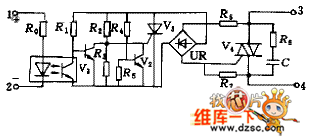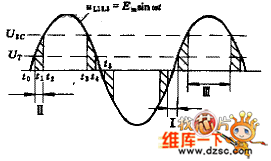Working principle Zero-crossing trigger type AC solid state relay SSR is a four-terminal device, and its internal circuit is shown in Figure 1. 1, 2 is the input, 3, 4 is the output. R0 is a current limiting resistor. The optocoupler electrically isolates the input and output circuits. V1 forms an inverter. R4, R5, V2 and thyristor V3 form a zero-crossing detection circuit. UR is a bidirectional rectifier bridge. V3 and UR. To obtain the bidirectional trigger pulse for turning on the triac V4, R3 and R7 are shunt resistors to protect V3 and V4, respectively. R8 and C form a surge absorption network to absorb the spike voltage or surge current in the power supply. To prevent impact or interference to the switching circuit.

It should be pointed out that the so-called "zero crossing" does not really have to be the zero point of the power supply voltage waveform, but generally refers to triggering in the region of 10 ~ 25V or - (10 ~ 25) V, as shown in Figure 2. In the figure, the AC voltage is divided into three regions, and the I region is in the range of -10V to +10V, which is called a dead zone. When an input signal is added to this region, the SSR cannot be turned on. The II zone is in the range of 10 to 25 V and - (10 to 25) V, which is called the response zone. In this zone, the SSR is turned on as soon as the input signal is added. The III region is in the range of amplitude greater than 25V, and the suppression region is added to the input signal in this region, and the conduction of the SSR is suppressed.

When no voltage signal is applied to the input terminal, the phototransistor of the optocoupler is turned off because it does not receive light, V1 is saturated, and V3 and V4 are turned off due to no trigger voltage, and the SSR is turned off. When an input signal is added, the light-emitting diodes in the optocoupler illuminate and the phototransistor saturates, causing V1 to turn off. At this time, if the voltage across V3 is in the range of -(10~25)V or 10~25V, as long as the voltage dividing resistors R4 and R5 are properly selected, V2 can be turned off, and V3 is turned on, so that V 4 A trigger pulse from R6→UR→V 3→UR→R7 or in the opposite direction is obtained on the control pole, and V4 is turned on, so that the load is connected to the AC power source. If the AC voltage waveform is in the III region of FIG. 2, the conduction of V3 and V4 is suppressed due to the saturation of V2, and the SSR is suppressed, thereby achieving zero-crossing trigger control. Since the 10 to 25 V amplitude is approximately "zero" compared to the power supply voltage amplitude. Therefore, the zero-crossing voltage is generally roughly defined as 0 to ±25 V, that is, in this region, the zero-crossing trigger type AC-SSR can be turned on as long as the input signal is added.
When the input voltage signal is removed, the phototransistor in the optocoupler is turned off, V1 is saturated, and V3 is turned off, but at this time, V4 remains on until the load current decreases with the supply voltage to be less than the holding current of the triac, SSR Only turned to the deadline.
The output device of the SSR can be divided into a bidirectional thyristor and two unidirectional thyristors in anti-parallel form. If the load is an inductive load such as a motor, its static voltage rise rate dv/dt is an important parameter. Since the unidirectional thyristor static voltage rise rate (200V/ms) is much higher than the commutation index of the triac (10V/ms), if two high-power unidirectional thyristors are used in anti-parallel instead of the tri-directional thyristor, the output power can be improved. On the other hand, it can also improve the impact resistance against surge current. This SSR is called enhanced SSR. All the same products, in order to match the original application line, to ensure the reliable operation of the system.
Flat Control Cable Also known as festoon cable, this flat cable fits in confined spaces such as overhead cranes and hoists. It sends signal and data to operate, measure, or regulate automated equipment.
Raw cable can be UL2651, UL20251 ,etc
Flat cable, IDC cable, flat cable wiring, ribbon cable harness, flexible flat cable
ETOP WIREHARNESS LIMITED , https://www.wireharnessetop.com